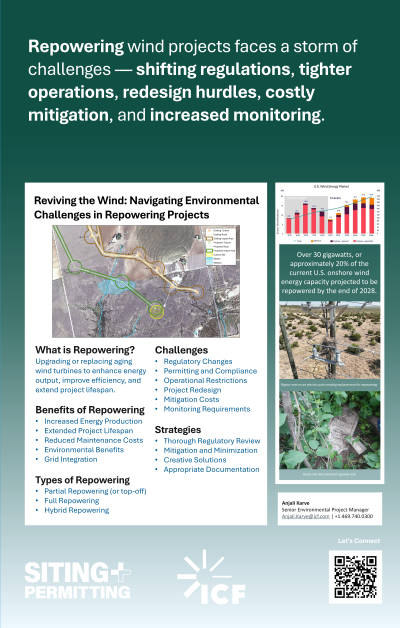Reviving the Wind: Navigating Environmental Challenges in Repowering Projects


Anjali Karve (she/her/hers)
Senior Environmental Project Manager
ICF
Frisco, Texas
Poster Presenter(s)
**All three proposals in this category were submitted with the idea they could all fit together for one session, although not submitted as a full panel officially**
Repowering a wind farm involves upgrading older turbines with more modern, efficient technology to increase energy production, extend the lifespan of the project, and reduce operational costs. This process typically replaces outdated turbines with fewer, larger, and more powerful units that capture more wind energy and operate more reliably. The benefits of repowering include greater energy output with fewer turbines, reduced maintenance, and the ability to maximize the use of existing infrastructure, such as roads and transmission lines. These upgrades help wind farms adapt to current market demands for renewable energy and improve the overall sustainability of wind power projects.
However, repowering brings potentially significant regulatory implications, as changing site conditions and evolving environmental regulations may require additional permits and compliance measures. For example, new U.S. Fish and Wildlife Service regulations, like the general eagle take permit, provide a programmatic framework for addressing impacts on protected eagles. Additionally, the potential new listings under the Endangered Species Act (e, g., tricolored bat) could require wind developers to secure new incidental take permits and/or adopt strategies to minimize harm. This means developers must conduct new environmental assessments, create detailed mitigation plans, and implement wildlife protection measures, such as turbine curtailment and shutdowns during high-risk periods. Repowering projects overall require updated or new permits for various regulatory programs and strategies to document compliance. Project planning often includes implementing new standards for wildlife protection, adding complexity to project timelines and costs. Navigating these regulatory changes, while balancing energy goals with resource protection, remains a critical challenge for developers aiming to extend the life of wind farms.
